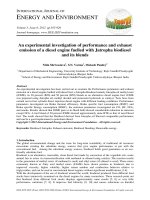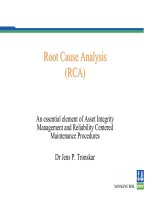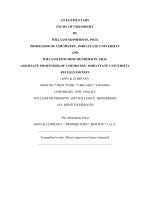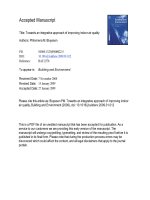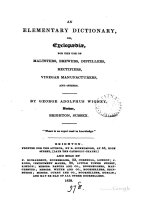Dragon Bone Hill: An Ice-Age Saga of Homo erectus
Bạn đang xem bản rút gọn của tài liệu. Xem và tải ngay bản đầy đủ của tài liệu tại đây (7.26 MB, 254 trang )
Dragon Bone Hill:
An Ice-Age Saga of
Homo erectus
NOEL T. BOAZ
RUSSELL L. CIOCHON
OXFORD UNIVERSITY PRESS
DRAGON BONE HILL
This page intentionally left blank
DRAGON BONE HILL
An Ice-Age Saga of Homo erectus
NOEL T. BOAZ
RUSSELL L. CIOCHON
2004
Oxford New York
Auckland Bangkok Buenos Aires Cape Town Chennai
Dar es Salaam Delhi Hong Kong Istanbul Karachi Kolkata
Kuala Lumpur Madrid Melbourne Mexico City Mumbai Nairobi
São Paulo Shanghai Taipei Tokyo Toronto
Copyright © 2004 by Oxford University Press
Published by Oxford University Press, Inc.
198 Madison Avenue, New York, New York 10016
www.oup.com
Oxford is a registered trademark of Oxford University Press
All rights reserved. No part of this publication
may be reproduced, stored in a retrieval system, or transmitted,
in any form or by any means, electronic, mechanical,
photocopying, recording, or otherwise, without the prior
permission of Oxford University Press.
Library of Congress Cataloging-in-Publication Data
Boaz, Noel Thomas.
Dragon Bone Hill : an Ice-Age saga of Homo erectus / Noel T. Boaz,
Russell L. Ciochon.
p. cm.
Includes bibliographical references and index.
ISBN 0-19-515291-3
1. Peking man.
2. Excavations (Archaeology)—China—Zhoukoudian.
3. Zhoukoudian (China)—Antiquities.
I. Ciochon, Russell L.
II. Title.
GN284.7.B63 2004
569.9—dc21
2003012339
1 3 5 7 9 8 6 4 2
Printed in the United States of America
on acid-free paper
To Lanpo Jia (1908–2001)
Chinese paleoanthropologist and discoverer of Skulls X, XI, and XII.
His dedication to Dragon Bone Hill saved the site’s excavation
data during World War II, and his regret was that he could not
do the same for the lost Peking Man fossils.
His ashes are buried at Zhoukoudian.
This page intentionally left blank
Contents
Preface ix
List of Illustrations xiii
CHAPTER 1 The Bones of Dragon Hill 1
CHAPTER 3 Giants and Genes: Changing Views of Peking Man’s
CHAPTER 4 The Third Function: A Hypothesis on the
CHAPTER 7 The Nature of Humanness at Longgushan:
CHAPTER 8 Alpha and Omega: Resolving the Ultimate Questions
of the Beginnings and Endings of Homo erectus,
CHAPTER 2 The Dragon Reclaims Its Own 33
Evolutionary Significance 55
Mysterious Skull of Peking Man 74
CHAPTER 5 The Adaptive Behavior of the Not-Quite-Human 90
CHAPTER 6 The Times and Climes of Homo erectus 108
Brain, Language, Fire, and Cannibalism 124
the Species 142
CHAPTER 9 Testing the New Hypotheses 161
Notes 181
Bibliography 197
Credits for Illustrations 217
Index 221
This page intentionally left blank
Preface
The coauthors of this book met in 1973 while they were both graduate
students in paleoanthropology at F. Clark Howell’s laboratory at the Uni-
versity of California at Berkeley. Although much of the lab’s focus was then
on Africa and Howell’s Omo Research Expedition to Ethiopia, China was
beginning to open up to renewed international paleoanthropological re-
search. Howell was a member of the paleoanthropology delegation from
the U.S. National Academy of Sciences to the People’s Republic of China
in 1975 and came back with news of great research possibilities. Ciochon
was soon after to begin his own research projects in Asia, beginning with
Burma in 1977, and extending over the next 25 years to India, China,
Vietnam, Cambodia, and Indonesia. Boaz, on the other hand, continued
his paleoanthropological research in Africa, working in Ethiopia, Libya,
and the Democratic Republic of Congo. About ten years ago, however,
their interests began to converge on the site of Zhoukoudian, also known
as “Dragon Bone Hill” (“Longgushan” in Chinese). In 1993 Boaz met
Professor Xiangqing Shao, a visiting physical anthropologist from Fudan
University in Shanghai, China, in a graduate seminar he was teaching at
George Washington University. Shao interested Boaz in renewed field re-
search at Zhoukoudian, and after they had exchanged several letters with
the Institute of Vertebrate Paleontology and Paleoanthropology in Beijing
(IVPP), a joint research project began to take form. The ensuing agreement
enabled the international and multi-institutional research on the Dragon
Bone Hill site that Boaz and Ciochon have undertaken with Chinese col-
leagues, and which forms the basis of this volume. Professor Shao later also
assisted Professor Alison Brooks of George Washington University in setting
up an archaeological field school at Zhoukoudian before his untimely death
ix
x Preface
in Washington, D.C., in 1999. Professor Shao is thanked for his role in
furthering Chinese-American scientific cooperation and international paleo-
anthropological research.
Our colleagues at IVPP in Beijing, Professor Qinqi Xu, former director
of the Zhoukoudian International Research Center, and Jinyi Liu, were
our coauthors on several professional papers published on this research.
They were instrumental in planning our joint research, in constructing
the Zhoukoudian excavation map, and in developing our collaborative
taphonomic research of the extensive Zhoukoudian collections housed in
Beijing and the Zhoukoudian Museum. Our January 1999 sojourn with
them at Zhoukoudian was memorable for demonstrating to us what a
chilly life it must have been for Peking Man in the Ice Age of northern
China, and for how grateful we were for the amenities of the warm and
hospitable Zhoukoudian guest house in which we stayed. Our many friends
and colleagues at IVPP—Professors Xinzhi Wu, Wei Dong, Yamei Hou,
Weiwen Huang, Wanbo Huang, and Yumin Gu, among others—are
thanked for their many kindnesses and for their hospitality during our
trips to China.
We owe a debt of gratitude to Professor Steve Weiner, chair of the De-
partment of Environmental Sciences at the Weizmann Institute of Science,
Rehovat, Israel, where Boaz spent the 1993–94 academic year as a Meyerhoff
Visiting Professor. Applying Weiner’s research methods—so successful in
elucidating the geochemistry of traces of fire at Hayonim Cave in Israel—
to the problem of fire at Zhoukoudian, seemed perfect. It was through Dr.
Weiner’s initiative that Dr. Xu went to Israel to learn the technique of X-
ray analysis of sediments, which set the stage for the team of Weiner, Paul
Goldberg, and Ofer Bar-Yosef to travel to China for the fieldwork that has
so enlightened and informed our understanding of fire and the sedimen-
tological history of Longgushan.
For access to collections and for productive and enjoyable discussions
related to Asian Homo erectus, we thank Ian Tattersall, Eric Delson, Ken
Mowbray, and Gary Sawyer of the American Museum of Natural History
and our Indonesian colleagues Y. Zaim and F. Aziz. Over the years our
discussions with G. H. R. von Koenigswald, F. Clark Howell, Sherwood
Washburn, Phillip Tobias, Alan Walker, Geoff Pope, John Olsen, Milford
Wolpoff, Philip Rightmire, Chris Stringer, John Fleagle, Alison Brooks,
Rick Potts, Jack Cronin, Alan Almquist, Yoel Rak, and Robert Franciscus
have contributed to the ideas presented in this volume. Peter Brown’s pa-
per at the 1991 “Pithecanthropus” symposium at the Senckenberg Mu-
seum in Frankfurt had a seminal effect on our thinking regarding Homo
erectus cranial thickness. Chris Davett of the Washington State University
Electron Microscope Center assisted with Scanning Electron Microscope
Preface xi
analysis. Sandy Martin and Lynette Nearn are thanked for their significant
contributions to our cranial pachyostosis studies. Christopher Janus, Lucian
Pye, and Martin Taschdjian provided valuable insights into historical as-
pects of the disappearance and search for the Peking Man fossils.
We thank the following for their help in archival and library research
for the project: Paula Willey of the American Museum of Natural History
Library, New York City; and Ken Rose, Mindy Gordon, Darwin Stapleton,
and Tom Rosenbaum of the Rockefeller Foundation Archives in Sleepy
Hollow, New York. We owe special thanks to the staffs of the libraries at
the University of Iowa (especially the interlibrary loan office), the Ross
University School of Medicine, Old Dominion University, the Weizmann
Institute of Science, Washington State University, Portland State Univer-
sity, the Portland (Oregon) Public Library, the University of California at
Berkeley, Georgetown University (Walter Granger and Lucille Swan Col-
lections), and the Smithsonian Institution (Frank Webb Collection).
John Olsen, Milford Wolpoff, and Robert Franciscus critically read the
manuscript and we thank them for many valuable comments and sugges-
tions. Rubén Uribe, Nathan Totten, Michael Zimmerman, and Erin Schem-
bari helped with computer graphics. Wei Dong graciously scanned early
photos of Zhoukoudian from the collections at the IVPP. Aidi Yin, M.D.
and Yaoming Gu, M.D., assisted us in translating from Chinese. Jessica White
commented on editorial issues. K. Lindsay Eaves-Johnson helped with edit-
ing the text and checking the bibliography. We thank our editors at Oxford
University Press, Kirk Jensen and Clifford Mills, for their patience and val-
ued assistance. Others who have assisted in forming our concepts and put-
ting them into written form include Bruce Nichols, Le Anh Tu Packard, and
Vittorio Maestro. We also acknowledge Le Anh Tu Packard for helpful com-
ments on the final draft of the manuscript. We also thank agent Susan Rabiner
for her help in promoting the project and Bill McCampbell for facilitating
it. Finally, Meleisa McDonell, Lydia Boaz, Peter Boaz, Alexander Boaz,
and Noriko Ikeda Ciochon are thanked for their patience and forbearance
while this book was being written. Funding for Boaz was provided by the
International Foundation for Human Evolutionary Research and the Ross
University School of Medicine. Funding for Ciochon was from the dean
of the College of Liberal Arts and Sciences, University of Iowa, and the
Human Evolution Research Fund of the University of Iowa Foundation.
Authors’ royalties from the sale of this volume will be donated to the
Zhoukoudian Museum at Dragon Bone Hill, a United Nations World Heri-
tage site.
Noel T. Boaz
Russell L. Ciochon
This page intentionally left blank
List of Illustrations
Page 2: (top) Map of Dragon Bone Hill (“Longgushan”) and Beijing.
(middle) Map of Longgushan and the town of Zhoukoudian. (bottom)
A plan view of Locality 1 with a history of the excavations.
Page 5: Swedish geologist J. Gunnar Andersson, who confirmed the pres-
ence of fossil bones near Zhoukoudian in 1918.
Page 11: The teeth of “Peking Man” found by Otto Zdansky at Longgushan
between 1921 and 1923.
Page 15: Davidson Black at his laboratory workbench with Sinanthropus
skulls.
Page 20: The cover page of Davidson Black’s 1927 paper announcing the
new species Sinanthropus pekinensis.
Page 23: The research team in the village of Zhoukoudian in 1929.
Page 28: Franz Weidenreich at Dragon Bone Hill after the recovery of
Skull X.
Page 30: View of the excavation in the spring of 1935.
Page 31: (top) Chief excavator Lanpo Jia in Locality 1 cleaning Skull XII in
November 1936. (bottom) Side view of Skull XII.
Page 34: View of the excavation on June 15, 1937.
Page 37: German paleoanthropologist Ralph von Koenigswald (center) in
1938 with Pierre Teilhard de Chardin (left) and Helmut de Terra (right)
in Java.
xiii
xiv List of Illustrations
Page 41: The front gate of Peking Union Medical College, Beijing, in the
late 1930s.
Page 44: Chief excavator Lanpo Jia at Longgushan on November 2, 1936.
Page 52: Franz Weidenreich at the American Museum of Natural History
in New York City.
Page 56: Anatomy of the Homo erectus skull as reconstructed by Franz
Weidenreich.
Page 64: Homo erectus molar compared to Gigantopithecus molar.
Page 66: Weidenreich’s trellis of multiregional evolution in the hominid
family proposed in 1945.
Page 69: Olduvai Hominid 9, a Homo erectus skullcap from Olduvai Gorge,
Tanzania.
Page 75: Skull III, showing the pronounced cranial thickness of the skull
of Homo erectus.
Page 78: Cranial capacity of Homo erectus compared with other hominids
and apes.
Page 79: The Homo erectus skull with reconstructed chewing muscles.
Page 82: Relative cranial thicknesses of modern Chinese Homo sapiens (top)
and Zhoukoudian Homo erectus (bottom).
Page 87: (top) Healed depressed skull fracture in a contemporary Homo
sapiens (United States) compared with Homo erectus Skull X (middle
and bottom).
Page 91: Longgushan workers drilling a hole for setting explosive charges
in 1927.
Page 92: Excavation grid marked with white paint near the end of the field
season, November 1935.
Page 93: (top) Excavation of Skulls X, XI, and XII in Locus L in 1936.
(bottom) Excavation plan view of Locus L.
Page 94: Computer-generated three-dimensional map of Locality 1.
Page 96: Quartz stone tools from Longgushan Locality 1.
Page 96: A large chopping tool made from stream-rounded quartz cobble
discovered at Longgushan Locality 1.
List of Illustrations xv
Page 99: Archaeologist Henri Breuil (center) and Teilhard de Chardin (left)
at Dragon Bone Hill in 1935.
Page 110: (top) Geological sketch of Dragon Bone Hill localities and sedi-
ments by Teilhard de Chardin. (bottom) View of Dragon Bone Hill from
the north.
Page 111: Map of the original localities established on Dragon Bone Hill.
Page 113: Teilhard de Chardin’s concept of past climate in northern China.
Page 117: Global paleomagnetic stratigraphy for the past 2.5 million years.
Page 118: Paleoclimatic curves for the Pleistocene, constructed by Chunlin
Zhou and colleagues.
Page 121: Homo erectus from Nariokotome, west of Lake Turkana, Kenya,
nicknamed “Turkana Boy.”
Page 126: Speech areas of the brain of Homo sapiens.
Page 131: (top) A close-up view of the sediments of Layer 10 with evidence
of fire. (bottom) Burned mammal bone derived from Layer 10 collected
by Steve Weiner.
Page 133: Skull of the giant cave hyena, Pachycrocuta brevirostris, excavated
from Longgushan.
Page 134: (top, middle) A probable hyaenid bite mark on the right brow-
ridge of Longgushan Homo erectus Skull V. (bottom) Scanning electron
micrograph of an impression of the right browridge of Skull V.
Page 136: (top) Scanning electron photomicrograph of prehistoric cut marks
made by a stone tool on mammal bone from the site of Nihewan in
northern China. (bottom) Bite mark made by a carnivore tooth on an-
other mammal bone from the site of Nihewan.
Page 137: (top) Bite marks made by carnivores on bones from Locality 1 at
Dragon Bone Hill. (bottom) Stone-tool cut marks made by Homo erectus
on a mammal bone from Locality 1.
Page 139: Scanning electron photomicrograph of a carnivore puncture mark
and a Homo erectus stone-tool cut mark on the same bone from Locality 1.
Page 140: Lucille Swan sculpting “Nellie,” a soft-part reconstruction of
Homo erectus, under the scientific direction of Franz Weidenreich.
Page 145: Javan Homo erectus skull, Sangiran 17.
xvi List of Illustrations
Page 146: Recently discovered fossil skull (left) of Homo erectus from the
site of Dmanisi, Republic of Georgia, compared with Homo habilis skull
ER 1813 (right) from east of Lake Turkana, Kenya.
Page 150: Clinal replacement as a model of human evolution, redrawn
from a diagram by population geneticist Sewall Wright.
Page 154: (right) Map of Pleistocene “Sunda” illustrating the probable mi-
gration route of Homo erectus and other terrestrial animals into island
Southeast Asia. (left) Map of the inundated Sunda Shelf in modern times.
Page 158: (top) The oxygen isotope paleotemperature record for the past
1.5 million years. (2nd from top) Relative strengths of the wet, summer
monsoons in northern China. (3rd from top) Relative strengths of the
cold, dry, winter monsoons in northern China. (bottom) History of wind-
blown glacial dust (“loess”) in northern China. All from the research of
D. Heslop and colleagues.
Page 163: Map of major hominid fossil sites dating to between one hun-
dred thousand and three million years ago.
Page 165: A view of the evolutionary, geographic, and temporal relation-
ships of Homo erectus, following Philip Rightmire.
Page 177: (top) The Upper Cave at Longgushan. (bottom) Skull of Homo
sapiens (no. 101) from the Upper Cave.
Color Illustrations Follow Page 76
Plate 1: (top) A reconstruction of Homo erectus from Longgushan by Ian
Tattersall and Gary Sawyer. (bottom) Stone tools from Locality 1 fash-
ioned by Homo erectus.
Plate 2: View of the western wall of the excavation at Locality 1 from
Pigeon Hall Cave.
Plate 3: A reconstructed three-dimensional map of the Locality 1 excava-
tion, showing the spatial extent and levels of all Homo erectus skulls.
Plate 4: (top) The Pleistocene cave hyena, Pachycrocuta brevirostris, was the
primary denizen of the cave at Dragon Bone Hill. (middle) Homo erectus
occupied Longgushan, probably near well-lit cave entrances, in the day-
light hours. (bottom) As night fell, when the hominids had scavenged
what they could, they left the cave to the hyenas.
List of Illustrations xvii
Plate 5: (top) Bite marks on hominid skulls show that hyenas crunched
away the face first, then gnawed on the calvaria to crack open the brain
case. (middle row, left) Some paired puncture marks on Homo erectus
crania match the canines of other carnivores. (middle row, middle) The
enlarged hole at the base of the skull was the handiwork of hyenas.
(middle row, right) A hominid skull fragment shows a hyena bite mark.
(bottom) Hominid thighbone shows damage that matches bones regur-
gitated by African hyenas.
Plate 6: The traditional interpretation of Zhoukoudian—the cave home of
Peking Man.
Plate 7: The new interpretation—Longgushan as fossil hyena den.
Plate 8: A reconstruction in stages of Homo erectus from Java by Japanese
anthropologist Professor Hisao Baba based on the 1.25-million-year-
old skull from Sangiran. Final reconstruction of Javan Homo erectus with
volcanos in the background by artist Jay Matternes.
This page intentionally left blank
DRAGON BONE HILL
This page intentionally left blank
CHAPTER 1
The Bones of Dragon Hill
In the 1920s, when the excavations started at Dragon Bone Hill, the
understanding of human evolution was in a confused state. Eugene Dubois,
the discoverer of Pithecanthropus from Java, was generally thought to have
gone a bit insane in his advanced years. He had buried the fossils under his
kitchen floor and had begun to think that he had discovered not the precur-
sor of the human species but a giant gibbon-like primate instead. Henry
Fairfield Osborn of the American Museum of Natural History was mount-
ing a major expedition to Asia to look for the ancestors of humanity so far
back in time that he ended up only with fossils of dinosaurs. A fossil tooth
of an extinct pig-like peccary from Nebraska was, for a brief time, mis-
taken for an early humanlike ape in America and named Hesperopithecus.
A fossil skull discovered by Raymond Dart in South Africa was named
Australopithecus and claimed as a new human ancestor from that conti-
nent. And Professor Frederick Wood Jones of England was developing his
elaborate albeit totally fallacious theory that humans had evolved directly
from tarsiers—small, nocturnal, leaping primates now found only in South-
east Asia. Adding to this already rich tapestry of confusion was the “Pilt-
down Man” hoax—a modern human skull, a broken orangutan jawbone,
and isolated teeth—planted in southern England and claimed by some to
be humanity’s oldest known ancestor. Out of this paleoanthropological
morass there arose in the 1930s a clear ancestor—adroitly discovered, ex-
pertly studied, meticulously published, and universally acclaimed. It be-
came widely known as “Peking Man.” This book is about that hominid,
1
now known scientifically as Homo erectus.
For much of the first half of the twentieth century, the smart money was
on Asia as the place of origin of the human lineage. Africa, a continent that
1
2 Dragon Bone Hill
The Bones of Dragon Bone Hill 3
future discoveries would make a fossil Mecca, was then virtually a blank on
the map of human fossils. Charles Darwin, intellectual grandfather of the
evolutionists, preferred Africa as the source of humanity, whereas Alfred
Russel Wallace, codeveloper of the theory of natural selection with Darwin,
had postulated Asia as the wellspring of the human lineage. The vast major-
ity of researchers agreed on this point with Wallace. German, Swedish, French,
Austrian, and American paleontologists flocked to China for the purpose of
finding the evolutionary Garden of Eden, but it was a Swedish geologist, J.
Gunnar Andersson, who hit real pay dirt. Andersson discovered, developed,
and first brought to international attention the northern Chinese site of
Dragon Bone Hill. A quarry known in Chinese as “Longgushan” and lo-
cated north of the village of Zhoukoudian, it would produce the largest
cache of early hominid fossils known up to that time. The massive excava-
tion that uncovered the fossils is today still the largest undertaken at a fossil
hominid site. The discoveries at Dragon Bone Hill, more than any other
single site, became central elements in the modern interpretation of human
evolution.
The Fortuity of Dragons: Longgushan and
Traditional Chinese Medicine
A mysterious affinity exists between the ancient dragons of Chinese myth
and the fossilized remains of extinct animals. This association was discov-
ered by accident. In 1899 the German naturalist K. A. Haberer traveled to
China to explore the natural history of the western parts of the country,
but was forced by the Boxer Rebellion to stay on the Chinese coast. In
Shanghai, Beijing, and other cities he discovered that Chinese apothecary
Facing page
Top: Dragon Bone Hill (“Longgushan”) is located 50 kilometers southwest of Beijing,
near the town of Zhoukoudian. Located strategically at the point where the Western
Hills meet the North Chinese Plain and near the Zhoukou River, Longgushan offered
shelter, nearby water, and a vantage point for prey for Pleistocene carnivores, and at
times, Homo erectus. Middle: The location of ancient dragon bone quarrying was on the
northeastern slope of Dragon Bone Hill, but when the site was rediscovered (and re-
named “Locality 1”) by scientists, excavation began on the northern slope of the hill.
Bottom: A plan view of Locality 1 with a history of the excavations. The first excavation
by Otto Zdansky was in 1921 above what was later named the “Lower Cave” and at the
entrance to the site used by visitors today. The last excavation was completed in 1980
under the direction Lanpo Jia. Pigeon Hall Cave (“Gezitang” in Chinese) was originally
dug out by generations of dragon bone quarriers. Dragon Bone Hill was designated a
United Nations World Heritage site in 1987.

